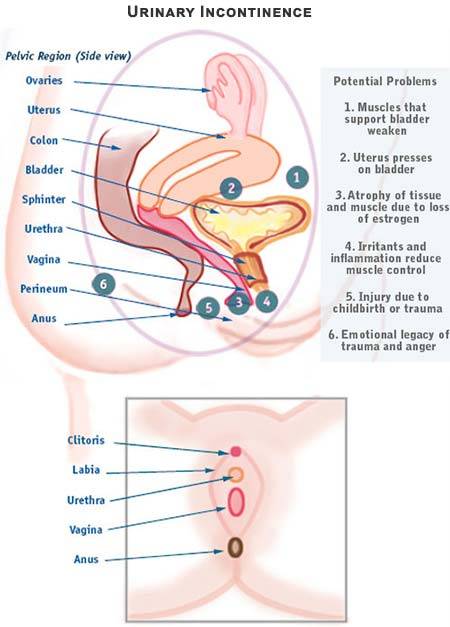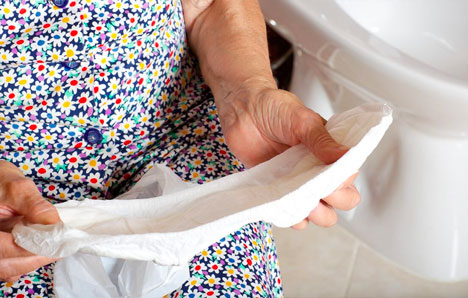Urinary Incontinence
 Urinary incontinence is the loss of control of your bladder. It can occur for several different reasons, and it can be treated. While it’s a fairly common condition, it can cause embarrassment, leading people to keep their symptoms to themselves. Causes can include:
Urinary incontinence is the loss of control of your bladder. It can occur for several different reasons, and it can be treated. While it’s a fairly common condition, it can cause embarrassment, leading people to keep their symptoms to themselves. Causes can include:
- Bladder muscles are weak
- Spastic or overactive muscles
- Damaged nerves around your bladder
- Medications
Urinary incontinence should always be evaluated with a thorough consultation and examination by your local gynecology specialist for an accurate diagnosis and treatment plan to exclude any underlying serious condition.
Symptoms and Risk Factors
Urinary continence can occur with a wide range of severity. You may find that the need to urinate comes upon you suddenly, with urgency and frequency. In fact, you may find it difficult to get to the bathroom in time; accidents aren’t unusual.
While aging is linked to incontinence, not everyone experiences it as they get older. In fact, there’s a greater link between gender and incontinence than between age and incontinence. For example, prostate problems put men at greater risk for incontinence.
Some studies have shown urinary incontinence to affect between 30-50% of women
For women, urinary incontinence often develops following a pregnancy. You many develop it during pregnancy, and if so, your chances of having it continue after pregnancy increase. Some women only experience it after they’ve given birth. The chance of incontinence increases with the birth of each child. Additionally, post-menopausal women are also at greater risk.
General risk factors for both genders include:
- Parkinson’s disease
- Multiple sclerosis
- Alzheimer’s disease
- Arthritis
- Stroke
- Certain medications
- Nerve damage as a result of injury or surgery
Urinary incontinence CAN be treated
All Symptoms should always be evaluated with a thorough consultation and examination by your gynecology specialist for an accurate diagnosis and treatment plan to exclude any underlying serious condition.
Types of Incontinence

There are several different types of incontinence, although it’s considered a symptom for another conditions and not a disease itself. Types of incontinence can include:
- Stress Urinary Incontinence (SUI) is a result of weak pelvic muscles. Because the pelvic floor muscles are weak or stretched out, leakage occurs. Stress incontinence mostly affects older women. SUI happens during physical activity, which puts pressure on your bladder, causing the leak. This may occur during exercise, when walking, with bending or lifting, or even sneezing, coughing or laughing. The leakage may be mild, moderate or severe, ranging from just a few drops of urine up to a tablespoon, sometimes more.
- Overactive Bladder (OAB) happens when your brain tells your body that you need to empty your bladder when in reality, it isn’t even full. You may feel a very abrupt urge to go that you can’t ignore, or you may find you feel you have to urinate constantly whether it’s day or night. With OAB, you may tend to stay home or limit your activities to be near a bathroom. You may find it hard to sleep at night with the urges to go disrupting your sleep patterns. This type of bladder incontinence shows up more in menopausal women.
- Mixed Incontinence happens when you experience both stress urinary incontinence and overactive bladder at the same time. This means there are moments when strong urges to urinate on a frequent basis occur, and other times when bladder leaks happen due to some activity.
- Overflow Incontinence is from a bladder that always thinks it’s full and therefore leaks fairly regularly. Additionally, you may find it difficult to completely empty your bladder. This could be due to a blockage or the bladder muscle’s inability to fully contract and empty the bladder completely. As a result, there are “dribbles” or leaks as your bladder attempts to release some of the pressure of what it thinks is a full bladder. This is actually rare in women and much more common in men with prostate problems.
- Functional Incontinence means your bladder is functioning normally, but you may have a physical or mental limitation, such as arthritis or Alzheimer’s disease, that doesn’t permit you to react or move quickly enough to make it to the toilet. It also includes any urinary issues that impair your quality of life.
- Temporary Urinary Incontinence occurs when certain food, drinks or medications are in your system and stimulate your bladder more frequently than usual. These include:
- Alcohol
- Caffeine
- Tea and coffee, whether regular or decaffeinated
- Soda and other carbonated beverages
- Artificial sweeteners
- Corn syrup
- Foods and beverages that are spicy, sugary or acidic, particularly citric fruits
- Heart and blood pressure pills, muscle relaxants and sedatives
- Large doses of vitamins B or C
- Urinary tract infection
- Constipation
With Testing Comes Diagnosis
Your Midtown NYC gynecologist will perform a history and physical on you to rule out other diseases or ailments that might be causing your bladder problems. There’s also a basic physical test to see how well your bladder holds: close your mouth, pinch your nose and exhale as hard as you can. But many other tests can tell your doctor how your bladder is functioning. Among things your doctor can do to rule more serious conditions out:
- Urinalysis
- Keeping a bladder diary, where you track your eating and drinking habits, as well as the frequency of your incontinence episodes
- Post-void residual measurement, a test where the gynecologist asks you to urinate into a cup to see how much your bladder is voiding on its own, and then does a test to see if there is any urine leftover in your bladder
- Urodynamic testing involves a catheter that fills your bladder with water and measures the pressure of your bladder during filling and emptying the bladder
- Cystoscopy, which uses a tiny tube with a lens that’s inserted into your urethra, so the gynecologist, can note or even remove any abnormalities occurring in your urinary tract
- Cystogram, which also uses a tiny tube inserted into your urethra; however in this test, the doctor injects dye and traces it through X-ray imaging to see how your bladder expels liquid
- Pelvic ultrasound, which checks for physical abnormalities of your organs and pelvis
Treatments
- Bladder training, where you train your body to go longer and longer between bathroom breaks
- Double voiding — going to the bathroom, waiting a few moments to see how your body feels, then trying to go again to ensure an empty bladder
- Scheduling your trips to the bathroom
- Managing your food and fluid intake
- Kegel exercises to strengthen your pelvic floor muscles
- Electrical stimulation
- Medications such as anticholinergics, mirabegron, alpha blockers, or topical estrogen cream
- Urethral insert, a tampon-like device that you insert before physical activities that triggers your incontinence
- Pessary, a stiff ring inserted into your vagina to hold your bladder up and prevent leaks
- Bulking material injections, Botox® injections or nerve stimulators
Surgery can sometimes be necessary. Your doctor may perform:
- A sling procedure
- A bladder neck suspension
- A prolapse surgery
- An artificial urinary sphincter insertion
If all else fails or you prefer not to try the medicines or surgeries, you can always choose between wearing pads and protective garments or wearing a catheter.
Symptoms should always be evaluated with a thorough consultation and examination by your gynecologist for an accurate diagnosis and treatment plan to exclude any underlying serious condition.
Important Reminder: This information is only intended to provide guidance, not definitive medical advice. Please consult ob/gyn doctor about your specific condition. Only a trained, experienced gynecologist can determine an accurate diagnosis and proper treatment.
Have questions about Urinary Incontinence? Schedule an appointment with NYC’s best OB Gynecologist, Dr. Fernando Mariz, today.
Updated on Jun 23, 2020 by Dr. Fernando Mariz (Gynecologist), Manhattan Women’s Health and Wellness
Best-in-class
New York Gynecology Clinic
Manhattan Specialty Care in the Press

Call now to make an appointment with our highly rated Manhattan Gynecology doctors regarding your health. We look forward to seeing you!
book online now
(212) 378-9987
New York City Locations:
Manhattan Women's Health & Wellness (Upper East Side)
983 Park Ave, Ste 1D17
New York, NY 10028
(212) 389-1904
Manhattan Women's Health & Wellness (Midtown)
51 East 25th St, Ste 451
New York, NY 10010
(212) 677-7654
Manhattan Women's Health & Wellness (Union Square)
55 W 17th St, Ste 104
New York, NY 10011
(212) 378-9985